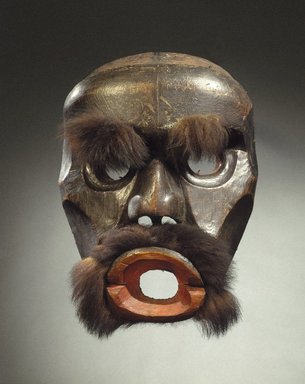
Artist:Kwakwaka'wakw
Medium: Cedar wood, fur (black bear?), hide, pigment, iron nails
Geograhical Locations:
Dates:19th century
Dimensions: 19 1/2 x 14 x 7 3/4 in. (49.5 x 35.6 x 19.7 cm)
Collections:
Exhibitions:
Accession Number: 15.513.1
Image: 15.513.1_SL1.jpg,
Catalogue Description: The Dzunuk'wa, or Cannibal women is a figure important to those Kwakwaka'wakw people who have an ancestral relationship to the stories involving her. She is a large, cumbersome figure, looking very bear like with shaggy fur over her body. She is clumsy and lumbers through the Northwest Coast cedar forests crying "Hoo Hoo Hoo" through her pursed lips. She is thought to carry a large woven basket with her. Should she discover a child who has disobeyed their parents and entered the woods without an adult she scoops them up into her basket and takes them to her den to eat them! Thus children are always warned against entering the forests without permission! Her mask is a large, and wooden, painted shiny black with spattered white pigment overall and accents of red pigment and fur. The mouth has a large round opening that is surrounded by prominent red lips. Pursed as if she is crying "hoo hoo." The interior of the eyes and nostrils that are large round holes painted red. Fur, possibly bear, attached with iron nails, surrounds the lips and forms the eyebrows. A previous application of fur on these areas is suggested by the appearance of corroded nails holding down remnants of fur plus extraneous nail holes. Used originally to secure the mask are leather thongs at the eyes, the back surface just below the eyes, and at the chin where they were attached to a leather strap. The ritual dance performed with this mask continues today by an individual who inherits the privilege. On the body of the dancer would be bear like regalia and the dancer mimics the clumsy gait of the real Dzunuk'wa. Some feast dishes have forms similar to those contained in these masks. The object is stable and in fair condition. Along the edges, especially on the lower, proper right side is old insect damage. Long vertical cracks are present in the wood, but appear stable.